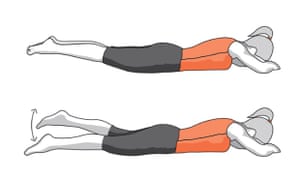
Swimmers
They might seem a long way from your knees, but the gluteal muscles in your bottom play a role in stabilising your legs. “Weakness in the glutes is common if they’re not specifically worked on,” says senior physiotherapist Sophie Apps. “Usually, they’re weaker on one side and this will often be reflected in a knee problem on that side.”
Lie on your front, with elbows bent so that you can rest your chin on your fingers. Engage your core, point your toes out behind you and then raise both legs in the air as far as you can. Now start pulsing the legs up and down alternately, kicking from the hip as though you’re doing a front-crawl kick. Keep going for one minute or as long as you can with good form. If you want to make it easier, rest the legs on the floor and raise one leg at a time while the other is on the floor.
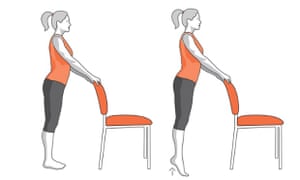
Calf raises
“The calf muscles extend behind the knee to cross over with the hamstrings,” says Sophie, “so they are also important players in keeping your knee moving as it should.”
This is a simple but effective exercise that repeatedly contracts and relaxes the calf muscles to build their strength. Stand with feet hip-width apart, holding on to a chair or table for balance if you need to. Raise yourself on to the balls of your feet and then back down to the floor. Repeat this movement fairly rapidly for one minute or as long as you manage.
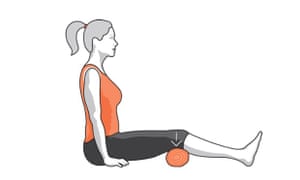
Thigh boosters
Your quadriceps are the muscles that make up most of the front of the thigh and they’re vital for the stability and healthy movement of the knee joint. “We all tend to have a stronger, dominant leg and this can lead to problems in the knee of the weaker leg,” says Sophie. “It’s important to work on the strength of both legs, two to three times a week, especially if you do a lot of sport.”
To strengthen your quads, sit with your legs straight out in front of you, toes pointing to the ceiling, hands beside you on the floor to support you. Sit tall and engage the core muscles around your middle. Place a rolled-up towel or cushion beneath your right knee, so that it gives it a slight bend. Now press down firmly with your knee and squash the towel. Hold for one second and release. Repeat up to 15 times. Take the towel out, place it under your left leg and repeat. If you’re wearing shorts, you’ll see the quad muscles around the knee contract and relax.
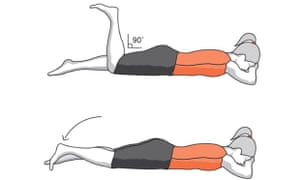
Hamstring curls
Your hamstrings are an important knee-stabilising muscle. “They run not only down the back of the thigh, but also down the back of the knee,” says Sophie. “For runners, they help to slow you down and speed you up, so if they’re weak, it’s going to lead to knee problems.”
This exercise boosts hamstring strength and control. Lie on your front with elbows bent and hands flat on the floor, so that you can rest your chin on your fingers. Bend your right knee up to a 90˚ angle, with the sole of your foot facing the ceiling – this is your start position.
Now bend your knee and tap your toe on the floor, then bend the knee and tap your bottom with your heel (or as close you can get it). Keep this movement going for one minute and then swap legs.
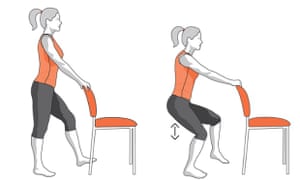
One-legged squat
This is another exercise for the quads and will give them a serious workout, as all of your bodyweight is going through one leg,” says Sophie. “Running is a single-leg activity – only one leg is on the ground at a time – so it’s an especially good one for runners.”
Stand with feet hip-width apart and rest a hand on a chair or table for balance. Lift your right leg off the floor and then bend the standing leg at the knee to go into a squat. Ensure that your knee does not extend out beyond your toes and keep your upper body upright (don’t bend from the waist).
Aim for a deep squat but just go as far as is comfortable. “Do 8-12 repetitions on each leg,” says Sophie. “If you can do fewer on a particular leg, it indicates that the leg is weaker and requires some extra work. Doing it without holding on to anything for balance will increase the benefits by forcing you to engage your core.”
No comments:
Post a Comment